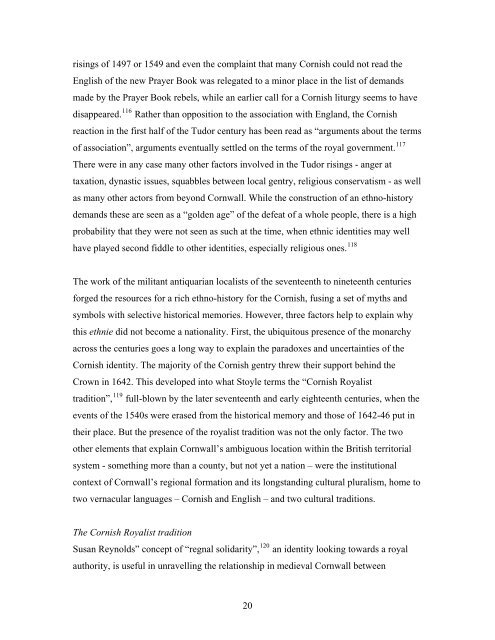Britishness, what it is and what it could be, is now high on both ...
Britishness, what it is and what it could be, is now high on both ...
Britishness, what it is and what it could be, is now high on both ...
Create successful ePaper yourself
Turn your PDF publications into a flip-book with our unique Google optimized e-Paper software.
<str<strong>on</strong>g>is</str<strong>on</strong>g>ings of 1497 or 1549 <str<strong>on</strong>g>and</str<strong>on</strong>g> even the complaint that many Corn<str<strong>on</strong>g>is</str<strong>on</strong>g>h <str<strong>on</strong>g>could</str<strong>on</strong>g> not read the<br />
Engl<str<strong>on</strong>g>is</str<strong>on</strong>g>h of the new Prayer Book was relegated to a minor place in the l<str<strong>on</strong>g>is</str<strong>on</strong>g>t of dem<str<strong>on</strong>g>and</str<strong>on</strong>g>s<br />
made by the Prayer Book re<str<strong>on</strong>g>be</str<strong>on</strong>g>ls, while an earlier call for a Corn<str<strong>on</strong>g>is</str<strong>on</strong>g>h l<str<strong>on</strong>g>it</str<strong>on</strong>g>urgy seems to have<br />
d<str<strong>on</strong>g>is</str<strong>on</strong>g>appeared. 116 Rather than oppos<str<strong>on</strong>g>it</str<strong>on</strong>g>i<strong>on</strong> to the associati<strong>on</strong> w<str<strong>on</strong>g>it</str<strong>on</strong>g>h Engl<str<strong>on</strong>g>and</str<strong>on</strong>g>, the Corn<str<strong>on</strong>g>is</str<strong>on</strong>g>h<br />
reacti<strong>on</strong> in the first half of the Tudor century has <str<strong>on</strong>g>be</str<strong>on</strong>g>en read as “arguments about the terms<br />
of associati<strong>on</strong>”, arguments eventually settled <strong>on</strong> the terms of the royal government. 117<br />
There were in any case many other factors involved in the Tudor r<str<strong>on</strong>g>is</str<strong>on</strong>g>ings - anger at<br />
taxati<strong>on</strong>, dynastic <str<strong>on</strong>g>is</str<strong>on</strong>g>sues, squabbles <str<strong>on</strong>g>be</str<strong>on</strong>g>tween local gentry, religious c<strong>on</strong>servat<str<strong>on</strong>g>is</str<strong>on</strong>g>m - as well<br />
as many other actors from <str<strong>on</strong>g>be</str<strong>on</strong>g>y<strong>on</strong>d Cornwall. While the c<strong>on</strong>structi<strong>on</strong> of an ethno-h<str<strong>on</strong>g>is</str<strong>on</strong>g>tory<br />
dem<str<strong>on</strong>g>and</str<strong>on</strong>g>s these are seen as a “golden age” of the defeat of a whole people, there <str<strong>on</strong>g>is</str<strong>on</strong>g> a <str<strong>on</strong>g>high</str<strong>on</strong>g><br />
probabil<str<strong>on</strong>g>it</str<strong>on</strong>g>y that they were not seen as such at the time, when ethnic ident<str<strong>on</strong>g>it</str<strong>on</strong>g>ies may well<br />
have played sec<strong>on</strong>d fiddle to other ident<str<strong>on</strong>g>it</str<strong>on</strong>g>ies, especially religious <strong>on</strong>es. 118<br />
The work of the mil<str<strong>on</strong>g>it</str<strong>on</strong>g>ant antiquarian local<str<strong>on</strong>g>is</str<strong>on</strong>g>ts of the seventeenth to nineteenth centuries<br />
forged the resources for a rich ethno-h<str<strong>on</strong>g>is</str<strong>on</strong>g>tory for the Corn<str<strong>on</strong>g>is</str<strong>on</strong>g>h, fusing a set of myths <str<strong>on</strong>g>and</str<strong>on</strong>g><br />
symbols w<str<strong>on</strong>g>it</str<strong>on</strong>g>h selective h<str<strong>on</strong>g>is</str<strong>on</strong>g>torical memories. However, three factors help to explain why<br />
th<str<strong>on</strong>g>is</str<strong>on</strong>g> ethnie did not <str<strong>on</strong>g>be</str<strong>on</strong>g>come a nati<strong>on</strong>al<str<strong>on</strong>g>it</str<strong>on</strong>g>y. First, the ubiqu<str<strong>on</strong>g>it</str<strong>on</strong>g>ous presence of the m<strong>on</strong>archy<br />
across the centuries goes a l<strong>on</strong>g way to explain the paradoxes <str<strong>on</strong>g>and</str<strong>on</strong>g> uncertainties of the<br />
Corn<str<strong>on</strong>g>is</str<strong>on</strong>g>h ident<str<strong>on</strong>g>it</str<strong>on</strong>g>y. The major<str<strong>on</strong>g>it</str<strong>on</strong>g>y of the Corn<str<strong>on</strong>g>is</str<strong>on</strong>g>h gentry threw their support <str<strong>on</strong>g>be</str<strong>on</strong>g>hind the<br />
Crown in 1642. Th<str<strong>on</strong>g>is</str<strong>on</strong>g> developed into <str<strong>on</strong>g>what</str<strong>on</strong>g> Stoyle terms the “Corn<str<strong>on</strong>g>is</str<strong>on</strong>g>h Royal<str<strong>on</strong>g>is</str<strong>on</strong>g>t<br />
trad<str<strong>on</strong>g>it</str<strong>on</strong>g>i<strong>on</strong>”, 119 full-blown by the later seventeenth <str<strong>on</strong>g>and</str<strong>on</strong>g> early eighteenth centuries, when the<br />
events of the 1540s were erased from the h<str<strong>on</strong>g>is</str<strong>on</strong>g>torical memory <str<strong>on</strong>g>and</str<strong>on</strong>g> those of 1642-46 put in<br />
their place. But the presence of the royal<str<strong>on</strong>g>is</str<strong>on</strong>g>t trad<str<strong>on</strong>g>it</str<strong>on</strong>g>i<strong>on</strong> was not the <strong>on</strong>ly factor. The two<br />
other elements that explain Cornwall’s ambiguous locati<strong>on</strong> w<str<strong>on</strong>g>it</str<strong>on</strong>g>hin the Br<str<strong>on</strong>g>it</str<strong>on</strong>g><str<strong>on</strong>g>is</str<strong>on</strong>g>h terr<str<strong>on</strong>g>it</str<strong>on</strong>g>orial<br />
system - something more than a county, but not yet a nati<strong>on</strong> – were the inst<str<strong>on</strong>g>it</str<strong>on</strong>g>uti<strong>on</strong>al<br />
c<strong>on</strong>text of Cornwall’s regi<strong>on</strong>al formati<strong>on</strong> <str<strong>on</strong>g>and</str<strong>on</strong>g> <str<strong>on</strong>g>it</str<strong>on</strong>g>s l<strong>on</strong>gst<str<strong>on</strong>g>and</str<strong>on</strong>g>ing cultural plural<str<strong>on</strong>g>is</str<strong>on</strong>g>m, home to<br />
two vernacular languages – Corn<str<strong>on</strong>g>is</str<strong>on</strong>g>h <str<strong>on</strong>g>and</str<strong>on</strong>g> Engl<str<strong>on</strong>g>is</str<strong>on</strong>g>h – <str<strong>on</strong>g>and</str<strong>on</strong>g> two cultural trad<str<strong>on</strong>g>it</str<strong>on</strong>g>i<strong>on</strong>s.<br />
The Corn<str<strong>on</strong>g>is</str<strong>on</strong>g>h Royal<str<strong>on</strong>g>is</str<strong>on</strong>g>t trad<str<strong>on</strong>g>it</str<strong>on</strong>g>i<strong>on</strong><br />
Susan Reynolds” c<strong>on</strong>cept of “regnal solidar<str<strong>on</strong>g>it</str<strong>on</strong>g>y”, 120 an ident<str<strong>on</strong>g>it</str<strong>on</strong>g>y looking towards a royal<br />
author<str<strong>on</strong>g>it</str<strong>on</strong>g>y, <str<strong>on</strong>g>is</str<strong>on</strong>g> useful in unravelling the relati<strong>on</strong>ship in medieval Cornwall <str<strong>on</strong>g>be</str<strong>on</strong>g>tween<br />
20
















